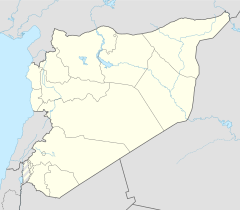Nhà thờ Hồi giáo Umayyad
| Nhà thờ Hồi giáo Umayyad الجامع الأموي | |
|---|---|
 Sân của nhà thờ Hồi giáo | |
| Tôn giáo | |
| Giáo phái | Hồi giáo |
| Vùng | Levant |
| Trạng thái | Hoạt động |
| Vị trí | |
| Vị trí | Damascus, Syria |
| Tọa độ địa lý | 33°30′43″B 36°18′24″Đ / 33,511944°B 36,306667°Đ |
| Kiến trúc | |
| Thể loại | Nhà thờ Hồi giáo |
| Phong cách | Umayyad |
| Hoàn thành | 715 |
| Đặc điểm kỹ thuật | |
| Tháp giáo đường | 3 |
| Chiều cao tháp | 253 ft |
| Vật liệu | Đá, đá cẩm thạch, ngói, khảm |
Nhà thờ Hồi giáo Umayyad hay Giáo đường Umayyad (tiếng Ả Rập: الجامع الأموي) còn được gọi là Đại giáo đường Damascus (tiếng Ả Rập: جامع بني أمية الكبير, La Mã hóa: Ğāmi' Banī 'Umayya al-Kabīr) là một nhà thờ Hồi giáo nằm ở thành phố cổ Damascus, là một trong những nhà thờ Hồi giáo lớn nhất và lâu đời nhất trên thế giới.
Sau cuộc chinh phục Damascus của người Hồi giáo vào năm 634, nhà thờ Hồi giáo được xây dựng trên địa điểm của một nhà thờ Kitô giáo dành riêng cho Thánh Gioan Baotixita (Yaḥyā ibn Zakarīyā), được tôn vinh như một nhà tiên tri của cả Kitô hữu và Hồi giáo. Một truyền thuyết có niên đại từ thế kỷ thứ 6 cho rằng, tòa nhà là nơi lưu giữ đầu của Gioan Baotixita.[1] Nhà thờ cũng được người Hồi giáo tin là nơi chúa Giê-su (Isa) sẽ trở lại vào ngày tận thế. Lăng mộ Saladin đứng trong một khu vườn nhỏ liền kề bức tường phía bắc của nhà thờ Hồi giáo.
Tài liệu tham khảo[sửa | sửa mã nguồn]
- ^ Burns, 2005, p.88.
Tham khảo[sửa | sửa mã nguồn]
- American architect and architecture, J. R. Osgood & Co, 1894.
- Bowersock, Glen Warren; Brown, Peter Lamont (2001). Interpreting late antiquity: essays on the postclassical world. Harvard University Press. ISBN 0-674-00598-8.
- Burns, Ross (2005), Damascus: A History, London: Routledge, ISBN 0-415-27105-3.
- Calcani, Giuliana; Abdulkarim, Maamoun (2003). Apollodorus of Damascus and Trajan's Column: from tradition to project. L'Erma di Bretschneider. ISBN 88-8265-233-5.
- Dumper, Michael; Stanley, Bruce E. (2007). Cities of the Middle East and North Africa: A Historical Encyclopedia. ABC-CLIO. ISBN 1-57607-919-8.
- Charette, François (2003), Mathematical instrumentation in fourteenth-century Egypt and Syria: the illustrated treatise of Najm al-Dīn al-Mīṣrī, BRILL, ISBN 978-90-04-13015-9
- Finkel, Caroline (2005), Osman's dream: the story of the Ottoman Empire, 1300-1923, Basic Books, ISBN 0-465-02396-7.
- Flood, Finbarr Barry (2001). The Great Mosque of Damascus: studies on the makings of an Umayyad visual culture. Boston: BRILL. ISBN 90-04-11638-9.
- Flood, Finbarr Barry (1997). “Umayyad Survivals and Mamluk Revivals: Qalawunid Architecture and the Great Mosque of Damascus”. Muqarnas. Boston: BRILL. 14: 57–79. doi:10.2307/1523236.
- Grafman, Rafi; Rosen-Ayalon, Myriam (1999). “The Two Great Syrian Umayyad Mosques: Jerusalem and Damascus”. Muqarnas. Boston: BRILL. 16: 1–15. doi:10.2307/1523262.
- Hitti, Phillip K. (tháng 10 năm 2002). History of Syria: Including Lebanon and Palestine. Piscataway, NJ: Gorgias Press LLC. ISBN 978-1-931956-60-4.[liên kết hỏng]
- Le Strange, Guy (1890), Palestine Under the Moslems: A Description of Syria and the Holy Land from A.D. 650 to 1500, Committee of the Palestine Exploration Fund (Ibn Jubayr: p.240 ff)
- Ibn Ṣaṣrā, Muḥammad ibn Muḥammad (1963). William M. Brinner (biên tập). A chronicle of Damascus, 1389-1397. University of California Press.
- Ibn Khaldūn; Fischel, Walter Joseph (1952). Ibn Khaldūn and Tamerlane: their historic meeting in Damascus, 1401 a.d. (803 a. h.) A study based on Arabic manuscripts of Ibn Khaldūn's "Autobiography". University of California Press.
- Kafescioǧlu, Çiǧdem (1999). “"In The Image of Rūm": Ottoman Architectural Patronage in Sixteenth-Century Aleppo and Damascus”. Muqarnas. BRILL. 16: 70–96. doi:10.2307/1523266.
- Kamal al-Din, Nuha; Ibn Kathir (2002). The Islamic view of Jesus. Islamic Books. ISBN 977-6005-08-X.
- Palestine Exploration Fund (1897), Quarterly statement, Published at the Fund's Office.
- Ring, Trudy; Salkin, Robert M.; Schellinger, Paul E. (1994), International Dictionary of Historic Places, Taylor & Francis, ISBN 1-884964-03-6
- Rivoira, Giovanni Teresio (1918), Moslem architecture: its origins and development, Oxford University Press.
- Selin, Helaine biên tập (1997), Encyclopaedia of the history of science, technology, and medicine in non-western cultures, Springer, ISBN 978-0-7923-4066-9.
- Walker, Bethany J. (tháng 3 năm 2004). “Commemorating the Sacred Spaces of the Past: The Mamluks and the Umayyad Mosque at Damascus”. Near Eastern Archaeology. The American Schools of Oriental Research. 67 (1): 26–39. doi:10.2307/4149989.
- Winter, Michael; Levanoni, Amalia (2004). The Mamluks in Egyptian and Syrian politics and society. BRILL. ISBN 90-04-13286-4.
- Van Leeuwen, Richard (1999), Waqfs and urban structures: the case of Ottoman Damascus, BRILL, ISBN 90-04-11299-5
- Wolff, Richard (2007), The Popular Encyclopedia of World Religions: A User-Friendly Guide to Their Beliefs, History, and Impact on Our World Today, Harvest House Publishers, ISBN 0-7369-2007-2
- Zaimeche, Salah; Ball, Lamaan (2005), Damascus, Manchester: Foundation for Science Technology and Culture
Liên kết ngoài[sửa | sửa mã nguồn]
| Wikimedia Commons có thêm hình ảnh và phương tiện truyền tải về Nhà thờ Hồi giáo Umayyad. |
- Christian Sahner, "A Glistening Crossroads," The Wall Street Journal, ngày 17 tháng 7 năm 2010 Lưu trữ 2010-07-30 tại Wayback Machine
- For freely downloadable, high-resolution photographs of the Umayyad Mosque (for teaching, research, cultural heritage work, and publication) by archaeologists, visit Manar al-Athar Lưu trữ 2020-01-23 tại Wayback Machine

